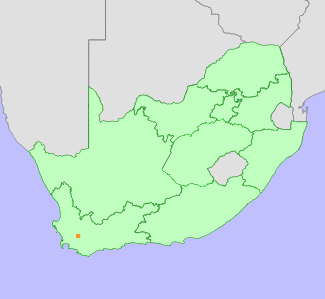|
Scientific Name | Leucospermum tottum (L.) R.Br. var. glabrum E.Phillips |
Higher Classification | Dicotyledons |
Family | PROTEACEAE |
Common Names | Du Toit's Ribbon Pincushion (e) |
National Status |
Status and Criteria | Critically Endangered B1ab(iii) |
Assessment Date | 2020/06/11 |
Assessor(s) | A.G. Rebelo, D. Raimondo & N.A. Helme |
Justification | Leucospermum tottum var. glabrum is a taxon restricted to one location in the Hex River Mountains in South Africa. It has an extent of occurrence (EOO) and an area of occupancy (AOO) of 20 km². The population consists of fewer than 200 mature individuals and there is ongoing decline as a result of too frequent fire and invasion by woody invasive plant species. It therefore qualifies as Critically Endangered under criterion B. |
Distribution |
Endemism | South African endemic |
Provincial distribution | Western Cape |
Range | This taxon is known from western Hex River Mountains, in the Fonteintjiesberg Nature Reserve, Western Cape Province, South Africa. |
Habitat and Ecology |
Major system | Terrestrial |
Major habitats | South Hex Sandstone Fynbos |
Description | It occurs on sandstone slopes, 800-1200 m. Mature individuals are killed by fires, and only seeds survive. Seeds are released after ripening, and dispersed by ants to their underground nests, where they are protected from predation and fire. It is pollinated by birds. |
Threats |
| There is ongoing habitat degradation as a result of the spreading invasive alien hakeas. The population has burnt frequently on a 10 year or less cycle for the past 30 years, these short fire return intervals are likely to be aggravating the dominance of invasive alien plants. |
Population |
This taxon occurs only in one valley in Hex River Mountains with a distribution range of 5 km in a single location at Jandutoitskloof. There are two subpopulations consisting of four stands of plants that numbered 15, 35, 50 and 10-100 plants during surveys conducted between 1992 and 2002. One plant was recorded in 2019 but this was an random observation and not part of a systematic survey of the population. With ongoing degradation of its habitat from too frequent fire and invasive alien plants the population is suspected to be declining.
|
Population trend | Decreasing |
Conservation |
| The easternmost known plants are in the Fonteintjiesberg Nature Reserve. |
Assessment History |
Taxon assessed |
Status and Criteria |
Citation/Red List version | | Leucospermum tottum (L.) R.Br. var. glabrum E.Phillips | CR B1ac(iv)+2ac(iv) | Raimondo et al. (2009) | |
Bibliography |
Raimondo, D., von Staden, L., Foden, W., Victor, J.E., Helme, N.A., Turner, R.C., Kamundi, D.A. and Manyama, P.A. 2009. Red List of South African Plants. Strelitzia 25. South African National Biodiversity Institute, Pretoria.
Rebelo, T. 2001. Sasol Proteas: A field guide to the proteas of southern Africa. (2nd ed.). Fernwood Press, Vlaeberg, Cape Town.
|
Citation |
| Rebelo, A.G., Raimondo, D. & Helme, N.A. 2020. Leucospermum tottum (L.) R.Br. var. glabrum E.Phillips. National Assessment: Red List of South African Plants version 2024.1. Accessed on 2025/11/18 |
 Comment on this assessment
Comment on this assessment

